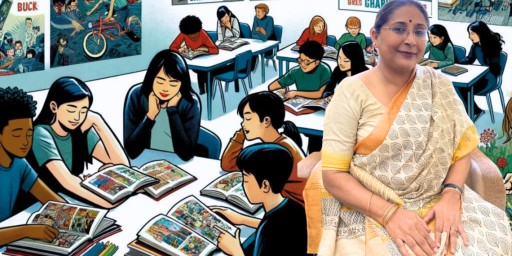Jasudben ML School & Bloomingdales Pre-Primary (JML) Explores the Impact of Graphic Novels on Student Engagement and Literacy
In today’s rapidly evolving educational and digital landscape, one of the biggest challenges parents and educators face is developing a love for reading among students, especially those who are reluctant or struggle with traditional texts due to dense text or number of pages. Enter graphic novels — a medium that has proven not just to catch the interest of these learners but also to significantly enhance their reading skills from pre-school. Rapidly evolving educational and digital landscape, one of the biggest challenges parents and educators face is developing a love for reading among students, especially those who are reluctant or struggle with traditional texts due to dense text or number of pages. Enter graphic novels — a medium that has proven not just to catch the interest of these learners but also to significantly enhance their reading skills from pre-school.
The inclusion of graphic novels in educational settings is further supported by initiatives like those under the National Education Policy (NEP) 2020, where education bodies have developed graphic novels such as ‘Cogito’ and ‘The Question Book’ to explain complex concepts like critical thinking and problem-solving in an engaging way.
Here’s a deeper look at why graphic novels are becoming an essential tool in classrooms.
1. Visual Literacy and Engagement
Graphic novels stand out through the vibrant illustrations that accompany the text. This combination is especially effective for students who find excessive text difficult and intimidating. The visual aspect of graphic novels makes processing the information easier and helps students stay focused on the story, thus reducing reading anxiety. It encourages visual literacy by allowing readers to interact and interpret both textual and graphical aspects, preparing students for a future where visuals play a dominant role in communication.
2. Simplified Reading Experience
Unlike conventional novels that may contain long paragraphs, graphic novels are organized with more white space, colors, and fewer words per page. This layout makes them less overwhelming and more approachable to students who may be overwhelmed by more traditional books.
3. Vocabulary Development
Graphic novels do not compromise on linguistic richness, despite being image-heavy. They introduce students to new vocabulary within the context of the story, aided by visual cues. This strategy helps in comprehension and retaining new words better, expanding students’ vocabulary more intuitively.
4. Enhanced Comprehension Skills
Graphic novels require readers to interpret information from both images and text, which necessitates a higher level of concentration and attention to detail. This dual involvement can help children improve comprehension skills as they learn to draw connections and infer meanings, which are transferable to other types of reading materials.
5. Intrinsic Motivation
The key benefit of graphic novels is their capacity to make reading fun. With engaging and interesting storylines and dynamic characters, these books are often more appealing and enjoyable than traditional literature, making them an effective tool in motivating students who would otherwise avoid reading to read more.
6. High-Quality Content
Graphic novels, like traditional novels, have interesting and intricate narratives, characters, and conflicts. The plots in graphic novels are rich with themes and concepts. They present narratives in a digestible format for students, making serious and complicated topics more accessible. The characters are developed and vibrant.
More than simply a stepping stone; Graphic novels are a legitimate form of literature capable of converting non-readers into enthusiastic book lovers. They can revolutionize the teaching-learning habits in our country.
Incredibly valuable for both the teacher and the students- it not only promotes application-based learning, critical thinking skills, and creativity but also helps students bridge learning gaps across classes. They play an important role in making literature enjoyable, and accessible and proving that reading can indeed be a pleasure, not just a chore.
More than simply a stepping stone, graphic novels are a legitimate form of literature capable of converting non-readers into enthusiastic book lovers. They can revolutionize the teaching-learning habits in our country. Incredibly valuable for both the teacher and the students, graphic novels not only promote application-based learning, critical thinking skills, and creativity but also help students bridge learning gaps across classes. They play an important role in making literature enjoyable, accessible, and proving that reading can indeed be a pleasure, not just a chore.
This article appeared in Prittle Prattle News an online portal on 26th May 2024.
